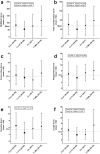Nasal microbiota clusters associate with inflammatory response, viral load, and symptom severity in experimental rhinovirus challenge
- PMID: 30061588
- PMCID: PMC6065324
- DOI: 10.1038/s41598-018-29793-w
Nasal microbiota clusters associate with inflammatory response, viral load, and symptom severity in experimental rhinovirus challenge
Abstract
The role of nasal and fecal microbiota in viral respiratory infections has not been established. We collected nasal swabs and washes, and fecal samples in a clinical study assessing the effect of probiotic Bifidobacterium animalis subsp. lactis Bl-04 on experimental rhinovirus infection. The nasal and fecal microbiota were characterized by 16S rRNA gene sequencing. The resulting data were compared with nasal inflammatory marker concentrations, viral load, and clinical symptoms. By using unsupervised clustering, the nasal microbiota divided into six clusters. The clusters predominant of Staphylococcus, Corynebacterium/Alloiococcus, Moraxella, and Pseudomonadaceae/Mixed had characteristic inflammatory marker and viral load profiles in nasal washes. The nasal microbiota clusters of subjects before the infection associated with the severity of clinical cold symptoms during rhinovirus infection. Rhinovirus infection and probiotic intervention did not significantly alter the composition of nasal or fecal microbiota. Our results suggest that nasal microbiota may influence the virus load, host innate immune response, and clinical symptoms during rhinovirus infection, however, further studies are needed.
Conflict of interest statement
R.B.T., S.M., and T.K. have received funding from DuPont Nutrition and Health that manufactures Bl-04. M.J.L., A.L., A.A.H., N.Y., S.F., L.L., B.S., and S.J.L. were employees of DuPont during the study.
Figures






References
-
- Turner, R. B. Rhinovirus. In Mandell, Douglas and Bennett’s Principles and Practice of Infectious Diseases Vol. 2 (eds J. E. Bennett, R. Dolin, & M. J. Blaser) Ch. 177, 2113–2121 (Elsevier, 2015).
Publication types
MeSH terms
Substances
LinkOut - more resources
Full Text Sources
Other Literature Sources

